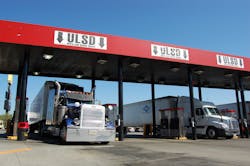Divergent paths for weekly diesel, gasoline prices
Prices for diesel and gasoline traveled in opposite directions for the week of March 19, according to data tracked by the Energy Information Administration (EIA).
The U.S. national average retail pump price for diesel inched down 4/10ths of a penny to $2.972 per gallon this week, the agency said, which is 43.3 cents per gallon higher compared to the same week in 2017.
Diesel prices only increased in three regions of the country this week, EIA noted: The Gulf coast, up 4/10ths of a penny to $2.786 per gallon; the Rocky Mountains, up 2.2 cents to $2.925 per gallon; and the West Coast with California excluded, up 8/10ths of a penny to $3.060 per gallon.
The West Coast, both with and without California’s prices included in the mix, was one of four U.S. areas where retail pump prices exceeded the $3 per gallon mark:
- New England: down 6/10ths of a penny to $3.101 per gallon
- The Central Atlantic: down 2.1 cents to $3.20 per gallon
- The West Coast with California’s prices included: down 2/10ths of a penny to $3.384 per gallon
- California: down 1.1 cents to $3.64 per gallon.
The U.S. national average retail pump price for gasoline, by contrast, jumped 3.9 cents this week to $2.598 per gallon, which is 27.7 cents per gallon higher compared to the same week in 2017.
Retail gasoline prices increased in every region of the country this week except for the Central Atlantic, where prices dipped 2/10ths of a penny to $2.628 per gallon.
In other energy news, EIA research indicates that annual average U.S. crude oil production grew by 463,000 barrels per day (b/d) in 2017 to 9.3 million b/d after declining by 551,000 b/d in 2016. In November 2017, monthly U.S. crude oil production grew 1.2 million b/d year-over-year and reached the highest level of production in U.S. history, surpassing 10 million b/d, a level last reached in 1970.
U.S. crude oil production has increased significantly over the past 10 years, driven mainly by production from tight rock formations using horizontal drilling and hydraulic fracturing techniques, which is usually referred to as “fracking.”
EIA projects that U.S. crude oil production will continue growing in 2018 and 2019, averaging 10.7 million b/d and 11.3 million b/d, respectively.
Texas remained the largest crude oil-producing state in 2017, averaging 3.5 million b/d. Texas also grew annual production more than all other states and the Federal Offshore Gulf of Mexico (GOM) in 2017, growing by 298,000 b/d. Significant growth occurred in several productive plays within the Permian region in Texas, with growth in the Permian area also driving New Mexico to the second-largest growth rate in 2017 with a 74,000 b/d increase.
New Mexico also surpassed California and Alaska to become the third-largest crude oil-producing state in the second half of 2017, EIA noted, although it produced less on an annual average basis.
In the GOM, new projects and expansions that started in 2016 ramped up production in 2017, which, along with two other projects that began in 2017, contributed to 51,000 b/d of annual growth.
Production levels in Colorado, Oklahoma, and North Dakota each grew by more than 30,000 b/d from 2016 to 2017, while Alaskan production increased only slightly. California’s production declined 34,000 b/d, the state’s third consecutive annual decline.
